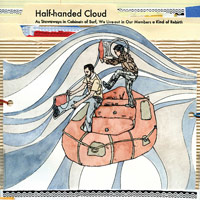
Halcyon Digest
4AD
Truth is, Deerhunter was a much more interesting band when its music was rambunctious and its persona less forgiving and more confrontational. Bradford Cox has reigned in the band’ sound on Halcyon Digest, the Atlanta group’s third full-length, to the nadir of Deerhunter’s public face. In most capacities, Cox is endlessly outspoken. For the bulk of Halcyon Digest, he barely ambles above a whisper, preferring to coo and burr with misanthropic puppy dog eyes. As always, Deerhunter truly does not deal in songs; these are standard indie-rock measures and blueprints modified to fit Cox’s take on the dreamier side of the Breeders, Stereolab and My Bloody Valentine. The whole record sounds muffled and blanketed, arriving from underground. Deerhunter deals, instead, in sensory manipulation through the use of colorful tiny explosions of aural ephemera. When those bursts are immediate, as on the deja vu melody in “Revival,” it becomes goosebump-inducing.
Still, Halcyon Digest is designed for darkness, a lonely rec-room psych made all the more ominous in the five-minute lament of “Sailing.” On “Earthquake,” the album’s lead, it appears as if Deerhunter’s often bright, babbling pop is being turned inside-out. It’s lazily spun, with Cox searching for an OK Computer-esque zenith within the borders of his basement. Time and space are on his side. Hypnotic downers, like the junkbox-electro warmth of “Helicopter” and the break-up dust and doo-woop of “Don’t Cry,” only magnify the moments when the band chooses grand, sweeping statements to punctuate the desolation of mood. It would be remiss to say that with fewer antics, and perhaps a full spin in the blogospheric cycle, Deerhunter is any less intriguing. Halcyon Digest is their most determined, fulfilling, and most importantly, grounded album to date, so it still appears that they have nowhere left to go but up.
Kevin J. Elliott

1,000 Years
Kill Rock Stars
If I was a betting man, I wouldn’t have put money on Corin Tucker being the first member of Sleater-Kinney to release, what is essentially, a solo album. When last we heard, Tucker was enjoying a domestic life at home as Sleater-Kinney went on hiatus. Now, here she is with a new record out, while her former bandmates have only just announced a new project (Wild Flag).
With the Corin Tucker Band consisting of producer and multi-instrumentalist Seth Lorinczi, drummer Sara Lund and vocalist Julianna Bright, 1,000 Years is obviously Corin’s record. Here she eschews social and political commentary and focuses instead on the personal. Tracks like “Half a World Away” and “It’s Always Summer” seem to make small commentary on balancing professional and family life. It’s not particularly revelatory, but Tucker doesn’t need to be at this point. Still, musically the album is cast in the same spitfire as her past work. The aforementioned “Half a World Away” is particularly evocative of Sleater-Kinney, Bright and Tucker replicating the dual-vocal attack for which that band was so well known, while the jagged guitars have a similar effect.
There is, in fact, nothing domesticated about this record. 1,000 Years is as fierce as anything Tucker has done in the past. Cuts like “Doubt” and “Riley” are strewn with raging guitars, while on songs like “Pulling Pieces,” the intensity is derived from skating between extremes. Tucker’s return is something of a surprise, but it turns out to be a very welcomed one at that.
Stephen Slaybaugh
MP3: “Doubt”

Stowaways
Asthmatic Kitty
In his heyday, Sufjan Stevens was quite the talent scout. His backing band, the Illinoisemakers, has proven to be quite the farm team, including My Brightest Diamond, and most famously, St. Vincent. But in a way it all began with Half-handed Cloud. The largely one-man band, known to his mother as John Ringerhofer, is the trombonist of the Illinoisemakers and the first artist other than Stevens to release music on Stevens’ Asthmatic Kitty label. And that relationship has continued with the release of Stowaways, Half-handed Cloud’s fifth album.
From first glance, it’s easy to see that Ringerhofer has more on his mind than the average troubadour. Take for example the full title of the album: As Stowaways in Cabinets of Surf, We Live-out in Our Members a Kind of Rebirth. Not exactly the easiest thing to fit on a t-shirt. And that’s before you see the genre classification, “Gospel & Religious.” Even the band’s name refers to an obscure Old Testament occurrence. But fear not heathens, the lyrics concern themselves with theological concerns so obscure and obtuse that most of the references will fly over your head. The focus on water and the sea are the most obvious motifs and anything past that will take a lot of work to decipher.
But that’s only part of the Stowaways story, Ringerhofer is disturbingly adept as writing pocket-sized, junk-orchestra pop songs. There are banjos, toy xylophones, trombones, piano, drums, guitars and a grab-bag of unidentifiable sounds, and yet it never sounds cluttered. Most songs clock in at less than two minutes, but within those short running times, there are no fragments or half-baked ideas. Every arrangement is economic but fully fleshed out, and each track is strong enough to stand alone but also function as a cog in a bigger machine.
If you could throw any criticism at Stowaways, it’s that due to the shortness of the tracks and the limited dynamic range of Ringerhofer’s voice it isn’t always easy to tell songs apart. But when you’re in the middle of songs like “Sonar Sends Bells To and Fro” or “The Sea Has No Face” it hardly matters. Even the godless masses can enjoy the gospel according to Half-handed Cloud.
Dorian S. Ham
MP3: “Armstrong’s Line”

Pink Nasty
self-released
“What I wouldn’t give to be on his mind.” Desperately I tried to put this line into context. I used the title of the song (“Nag, Nag, Nag”); I thought about the melody and the rhythm (post–Veruca Salt vocals over Wilco country-drag acoustic rock); I pondered why it sounded the way it did. Does this really sound as pathetic and desperate as it sounded initially in context? Maybe she is spiteful and this is a sharp jab at someone who thinks she’s that desperate? Is this a sarcastic line leading me to a punch line I won’t get because I’m a boy? Damnit. I couldn’t pay attention because it sounded like Weezer. Millions of people have the Blue Album, why wouldn’t they just put the Blue Album on instead of this? I expected something pink, original and nasty. Instead I got a Xerox of a copy of cardboard.
The song “The Pink Album” actually sounds like a Weezer song (Weezer being one of Pink Nasty’s sited influences), right down to the single-string guitar melody and power-chord arena-rock intro—straight off the Blue Album (I think there’s a joke here). This song is directly after “Eating Nerds,” which features a high register four-on-the-floor guitar rhythm, a la Nick Valensi, which is soon accompanied by a staccato lead guitar, as if played by Albert Hammond, Jr. Wait a minute—perhaps the only reason I site these two guitarists is not because they invented the jangle plus noodle rock-hook system, but because Pink Nasty sited the Strokes as another influence on her myspace page. Ladies and Gentlemen this hurts to review, because our guitar-driven girl rocker, Pink Nasty, did not even mention any other girl bands to which she owes her pilfered sound. Juliana Hatfield, Scrawl, Kaia or Team Dresch, Helium... hell, Nico or Nina Simone would have worked. There’s no point in trying to just sound like the boys, unless that’s what you “wouldn’t give to be on his mind.” Imitation is the highest form of flattery, and flattery will get you everywhere. If it counts for anything, the one and only Bonnie Prince Billy played with Pink Nasty on the last album and she opened for the guy from Spoon. Lord, give me back the Vegas Beat or the Butchies. I’ll even settle for Lois.
Michael P. O’Shaughnessy

History of Modern
Bright Antenna
“Return to form” is a phrase probably used far too often in describing “comeback” albums. But if there is a record that can be called such it is the new album from OMD (a.k.a. Orchestral Manouevres in the Dark), the band’s first since 1996. Not only is History of Modern the first record to reunite principal members Andy McCluskey and Paul Humphreys (McCluskey had carried on under the OMD banner for two more albums after Humphreys exited in 1989), it also marks the return of Martin Cooper and Malcolm Holmes, who played on the benchmark Architecture & Morality, among other albums. In another emphasized nod to the band’s past, the sleeve was designed by Peter Saville, the house designer for Factory Records who created the artwork for most of OMD’s discography. That the record—from the motorifik “The Future, The Past, and Forever After” to the minimal “Pulse” and the electro reprising of gospel standard “Motherless Child” on the splendorous “Sometimes”—lives up to band’s legacy is what really matters, and in that sense, it’s appropriate to use any cliches that apply. Indeed, OMD manages to conjure the sound that made them great even before they hit pay dirt (with “If You Leave”) while still sounding remarkably of the here and now.
Stephen Slaybaugh
ALBUM REVIEWS
Black Milk, Album of the Year
Chromeo, Business Casual
Dungen, Skit I Allt
James, The Morning After the Night Before
La Strada, New Home
Crocodiles, Sleep Forever
The Thermals, Personal Life
Wait. Think. Fast. Luces del Sur
Winter Gloves, All Red
The Intelligence, Males
Mice Parade, What It Means to Be Left-Handed
The Vaselines, Sex with an X
Interpol, Interpol
Electric Sunset, Electric Sunset
